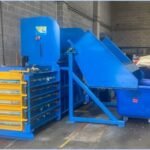What to Look for When Purchasing an Industrial Baler for Sale: Key Features Explained
Industrial balers have become essential equipment in various industries, particularly in waste management, recycling, and manufacturing sectors. They help compress large volumes of recyclable or waste materials into compact, manageable bales, facilitating easier storage, transportation, and disposal. If you are considering buying an industrial baler for sale, understanding the key features and specifications is crucial to ensure you invest in a machine that meets your operational needs effectively.
Understanding the Types of Industrial Balers
Before diving into the specific features, it’s important to recognize that industrial balers come in different types, each suited to particular materials and volumes. The most common types include vertical balers and horizontal balers. Vertical balers are typically smaller, designed for compact spaces and lower throughput, suitable for businesses handling lighter volumes of materials like cardboard or plastic film. Horizontal balers, on the other hand, are more robust, designed for high-volume operations, capable of handling heavier materials such as metals, plastics, and mixed recyclables. Selecting the right type based on your business requirements is the first step when searching for an industrial baler for sale.
Assessing the Baling Capacity and Bale Size
The baling capacity, usually measured in tons or pounds per cycle, is a critical factor to consider. It determines how much material the baler can compress at once, which directly impacts productivity. A machine with a higher baling capacity is ideal for larger operations, as it can handle substantial volumes without frequent stops. Additionally, the size and density of the finished bale affect storage efficiency and shipping costs. Some balers offer adjustable bale sizes and densities, allowing customization based on the type of material and space constraints. When evaluating an industrial baler for sale, ensure the capacity aligns with your waste output and operational goals.
Power Source and Energy Efficiency
Industrial balers operate using various power sources, including hydraulic, electric, or a combination of both. Hydraulic balers are prevalent due to their ability to generate significant compression force, making them suitable for dense materials. However, they tend to consume more energy and require regular maintenance of hydraulic components. Electric balers may offer quieter operation and energy efficiency, particularly for smaller loads. Evaluating the power requirements and energy consumption is essential, not only for operational efficiency but also for long-term cost savings and sustainability goals.
Safety Features and Compliance
Safety is paramount when operating heavy machinery like industrial balers. Modern balers come equipped with multiple safety mechanisms such as emergency stop buttons, safety interlocks, guards, and sensors to prevent accidents. Some machines also feature automatic shutdown if the operator opens the door during the baling process. When purchasing an industrial baler for sale, ensure it complies with local safety standards and regulations. Investing in equipment with advanced safety features protects your workforce and minimizes liability risks.
Durability and Maintenance Requirements
The durability of an industrial baler greatly influences its lifespan and reliability. Machines constructed with high-quality materials, such as reinforced steel, are more resistant to wear and tear in demanding industrial environments. Additionally, the design should facilitate easy access to components for routine maintenance and repairs. Balers with modular parts and clear maintenance protocols reduce downtime and associated costs. When considering an industrial baler for sale, inquire about the manufacturer’s warranty, service support, and availability of spare parts to ensure sustained performance.
Automation and Control Systems
The level of automation can vary significantly among industrial balers. Basic models might require manual feeding and operation, whereas advanced systems incorporate automated feeding conveyors, programmable logic controllers (PLC), and digital controls. These features can enhance efficiency, reduce manual labor, and improve consistency in bale formation. Depending on your operational scale and budget, you may prioritize balers with user-friendly control panels, remote monitoring capabilities, and customizable settings. Such automation features help optimize your baling process and reduce human error.
Conclusion
Purchasing an industrial baler for sale is a significant investment that can streamline your waste management or recycling processes. By understanding the types of balers, evaluating their capacity, power sources, safety features, durability, and automation capabilities, you can select a machine tailored to your specific needs. Careful consideration of these key features ensures that your industrial baler delivers optimal performance, safety, and cost efficiency, ultimately supporting your business’s sustainability and operational goals.






